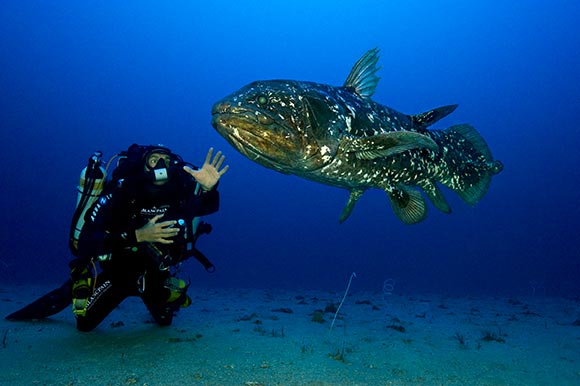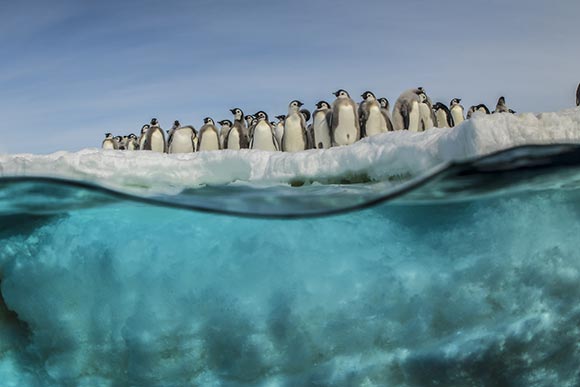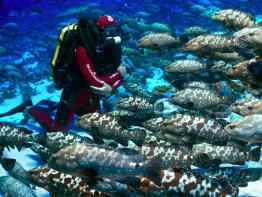Blancpain’s history is closely linked with that of diving. It all began in 1953, when the company launched the Fifty Fathoms watch, named for its depth rating of 50 fathoms or 91 metres (a fathom is six feet). The timepiece was the result of a partnership between Blancpain’s then-president Jean-Jacques Fiechter, who was a passionate diver, and Captain Robert Maloubier and Lieutenant Claude Riffaud, who had been entrusted by the French ministry of defence with setting up an elite “Combat Divers” unit. Having failed to find a watch that was capable of performing under the extreme conditions demanded by underwater missions, the two officers approached Blancpain with a very precise set of requirements. Thus was born the first modern diving watch, which rapidly gained iconic status. Subsequently, Blancpain has added the mission to preserve the world’s oceans to its commitment to keep accurate time.
In recent years, the company’s commitment to the seabed has taken the form of partnerships with various international organisations, scientists and underwater photographers. Laurent Ballesta’s Gombessa project is one such.
The Gombessa expeditions
Laurent Ballesta, a marine biologist, scientific diver and underwater photographer, is head of the Gombessa project, which was developed to promote a better understanding of inaccessible and poorly understood deep-water ecosystems. To date, Laurent Ballesta and his team have conducted three major expeditions sponsored by Blancpain.
Gombessa I, the culmination of two years’ scientific, logistical and human preparation, set out to study the legendary coelacanth, a fish linked with the emergence of terrestrial vertebrates around 365 million years ago. Known in South Africa as the Gombessa, this “living fossil” was rediscovered in 1938, and is recognised as being the greatest zoological discovery of the 20th century. Laurent Ballesta did what no one had done before; he dived to a depth of greater than 100 metres off the coast of South Africa to film living coelacanths and observe their behaviour in their natural habitat.

For Gombessa II, Laurent Ballesta went to French Polynesia to shed light on the mystery of spawning groupers. Every year, once a year at the full moon, marbled groupers respond to a mysterious signal and gather in the Tuamotu Archipelago. The mission represented a major challenge, which Laurent Ballesta and his team enthusiastically took on. A 24-hour dive was necessary in order to observe and monitor each phase of the groupers’ behaviour, giving a greater understanding of the role of this unique phenomenon in the ecosystem of the lagoon.
Gombessa III was the underwater part of a bigger project called “Wild Touch Expeditions – Antarctica”, led by filmmaker Luc Jacquet, who won an Oscar for best documentary for his film “March of the Penguins”. The expedition headed to Antarctica to conduct dives beneath the pack ice, bringing back the very first naturalist images of the area’s deep-sea ecosystems. The images taken during the mission were made available to researchers, and will contribute to an inventory of deep-sea fauna. The South Polar expedition is also intended to raise awareness of the impact of global warming.

The three Gombessa projects are targeted at both the scientific community and the general public. Each expedition has been followed up by books, exhibitions and documentary films, some of which were produced by Franco-German broadcaster Arte. The film of the latest expedition to date, Gombessa III, will be broadcast this coming autumn on Arte.
Blancpain Ocean Commitment – a global concept
The Gombessa project is part of the Blancpain Ocean Commitment, a global concept that brings together Blancpain’s various activities in the protection and preservation of deep-sea habitats. Blancpain has supported a number of scientific campaigns in addition to those led by Laurent Ballesta, including the National Geographic Pristine Seas Expeditions led by Dr Enric Sala. Today, Blancpain is investing in a project spearheaded by The Economist in connection with the World Ocean Summit and the Ocean Innovation Challenge.
In order to raise awareness of the wonders of the ocean, every year since 2008 Blancpain has published the Fifty Fathoms Edition Magazine, packed with breathtaking images. It is also a partner of World Oceans Day, set up by the UN in 2009, as part of which it organises a “Blancpain Ocean Commitment” roadshow. More information on all of Blancpain’s marine activities can be found on blancpain-ocean-commitment.com, an innovative platform that provides real-time information about the scientific expeditions. The site also features a section on the history of the expeditions, a gallery with hundreds of high-definition underwater photographs and a selection of video clips.
Click on the image at the top of the article to see more photos of Laurent Ballesta and the Gombessa expeditions.





